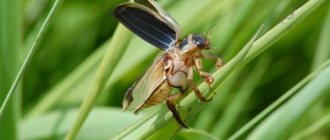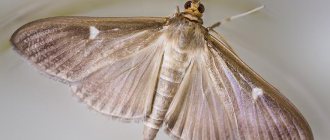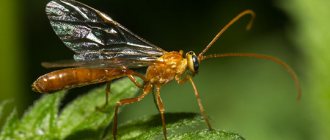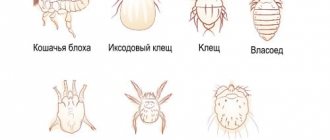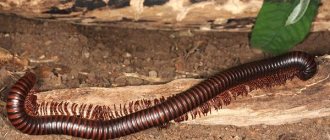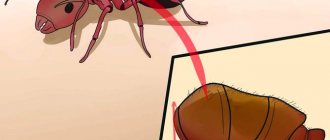The marbled bug (Holyomorpha halys) belongs to the category of stink bugs and the order of Hemiptera. It is also called the brown marmorated bug. The bug's body resembles a pear fruit. It is called marbled because white and black spots are scattered throughout the body of this type of bug. The body shape is slightly flattened and resembles a shield. This is where the name came from.
Dimensions do not exceed 12-18 millimeters in length. The general color of the adult is brown or dark gray. Paws are brown. The antennae have white stripes. Seeing such stripes on the antennae of a bug, you can determine its identity. The peritoneum is light in color. The wings are membranous with dark markings. An adult bug can fly. The larva of the marbled bug is not adapted to flight.
Habitat
According to Timiryazev University, the bug first appeared in Russia sometime in 2014. Scientists of the Agrarian University. K. A. Timiryazeva, together with colleagues of the North Caucasus Horticultural Center, argue: early detection of the pest (marbled bug) allows you to save from 25 to 45% of the harvest. Therefore, preventive measures are very important. This approach is especially relevant for farms, large plantations of grapes, citrus fruits and other types of fruit-bearing crops. Preventive measures will help preserve the harvest and prevent loss of profit. It is worth adding that the shield bug or marbled bug is included in the Unified List of Quarantine Objects. Therefore, Rosselkhoznadzor can impose sanctions on products imported into the Russian Federation.
The homeland of the marbled bug is considered to be the countries of Southeast Asia, including China, Japan, as well as the countries of the Korean Peninsula, Taiwan and Vietnam.
What does it eat?
The marbled bug, like absolutely all bedbugs, has a piercing-sucking mouthparts. With its proboscis, the insect creates a puncture and sucks out juice from stems, leaves, inflorescences, buds, pods, fruits, berries and vegetables. His food, although strictly vegetarian, is still extremely varied. Marbled bugs happily feed on dozens of plant types, causing damage to a wide range of agricultural crops.
The menu of the marbled bug includes nuts, fruits, vegetables, grains and berries. The smelly pest's diet includes apples and pears, peach and apricots, citrus fruits and figs, beans and peas. This list also includes grapes, raspberries and blueberries, tomatoes and cucumbers, hazelnuts and pistachios, sweet peppers, dark nightshade and sunflower.
The marbled bug eats not only fruits, but also young shoots, buds, leaves, and stems. In the absence of cultivated plants, this insect makes do with wild and weed vegetation, so starvation certainly does not threaten this type of bug.
Description and features
A small bug with a thyroid-shaped body can fly. Under the brown-gray pentagonal shell are membranous wings with dark spots. The length of an adult is 12-17 mm. It is not easy to distinguish the stink bug from its relatives.
But you can recognize the enemy by the white stripes located on the legs and antennae. Dark and light spots on the shell create marble graphics, which is how the bug got its name. The insect's peritoneum is light. If you look closely, you can see bluish spots on the head.
The scientific name of the insect is halyomorpha halys, the popular version is the Asian stink bug. The unflattering nickname was not given by chance. The bug emits an extremely unpleasant odor in two cases:
- to attract a couple of the opposite sex;
- in case of danger.
The marbled bug is easy to distinguish from harmless stink bugs by its black and white antennae
Special glands in the lower abdomen accumulate a special secretion until needed. The stink bug has been included in the list of quarantine objects since 2021, but this fact does not stop the insect from massively settling into houses, outbuildings, and storage facilities, where it has something to profit from.
The marbled bug is an insect of the order Hemiptera and is a plant pest. The oral apparatus of the shield bug is designed in such a way that it is capable of piercing the outer shell of plant fruits with a special proboscis, sucking out the juice, introducing saliva with enzymes.
After a bug's meal, the plant is susceptible to diseases and developmental disorders. The puncture site turns black, and plant tissue necrosis develops due to bacterial infection of the fetus.
The marbled bug is very harmful to plant productivity
Deformation and structural changes in the pulp affect the taste of fruits and vegetables. Unripe fruits fall off as their development stops; those remaining on trees and bushes rot.
Almost all plants are susceptible to stink bug attacks, but mostly fruit, grain, and vegetable crops. In Asia, the homeland of the marbled bug, scientists count over 300 plants that have been attacked by it, including flowers, shrubs, and vines.
Persimmons and tangerines fall off, hazelnuts hang empty, and spoiled grapes cannot be used to make juice or wine. The losses caused by the agricultural pest reach 40-70% of the total harvest. Huge financial losses befall gardeners and farmers due to the inability to export fruit crops.
In the United States, annual statistics record losses of tens of billions of dollars from bedbug infestations. The appearance of the pest in neighboring Abkhazia and in the southern regions of our country is causing concern among the population.
It is easy to notice the appearance of a bug in a garden plot by its characteristic smelly secretion, reminiscent of the secretions of a skunk or ferret. In nature, this ability serves as protection against enemies who avoid communicating with “fragrant” insects.
If you pick up a bug in your hands, the smell will linger on your palms for a long time. In people prone to allergic reactions, this phenomenon can cause, in addition to discomfort, painful manifestations.
Signs of appearance
This type of bug produces a very smelly secretion. Therefore, a person can immediately notice its appearance on his personal plot. The unpleasant aroma is intended to protect the bug from other representatives of the animal world. A special odor is produced by the endocrine glands and is similar to the odor emitted by a skunk or ferret. That’s why the common people also call it the “stink bug.” If you pick up such a bug in your hands, the unpleasant smell will remain on them for a long time.
The bug migrated from the countries of Southeast Asia. Gradually spread throughout America, Canada and England. In our country they live mainly in the territory of Abkhazia and the Krasnodar Territory. The climate prefers humid and warm.
How to lure out bedbugs - the principle of operation of traps
Considering that parasites react to substances secreted by the human body, it is difficult to create a trap for bedbugs with your own hands. But there are still some methods. For example, devices that are installed in the path of parasite movement are particularly effective.
Foreign odors (for example, food) are not interesting to insects, so it is not advisable to use attractants. If you set a trap where the parasite is likely to crawl, it will work. Adhesive pads, containers with liquids and fatty components operate on this principle.
For this reason, they are usually installed as close as possible to a person’s sleeping place. There are also more complex devices, for example, carbon dioxide-based devices or pheromone traps. The principle of their operation is based on the ability to emit characteristic aromas that will attract only bedbugs.
Arina, 32 years old, Kazan
If I suspect the appearance of bedbugs (there has already been a case once), I simply do 2 things: I put the legs of the bed in homemade traps at night (a description of how to do this can be found if desired), and I hang a breathable fabric on top of the bed. In the morning I call the exterminators.
Irina, 42 years old, Moscow
I tried special traps for bedbugs, but they didn’t help. I saved myself with glue strips - I left it all over the apartment, and most importantly, next to the bed. And it was good - in the morning it was immediately clear who was crawling where.
Glue traps work
Reproduction
The time for reproduction of the marbled bug is spring. Around mid-April. The female bedbug lays about 20-35 eggs. In this case, the total fertility of the female will be 200-350 eggs. Then he attaches the laid eggs to the back of the leaf. The size of the eggs varies from 1.3 to 1.7 millimeters.
Here are its breeding periods:
- May-June (mid-month);
- July-August (end of the month);
- August-October (mid-month).
Scientists call the process of reproduction itself “traumatic.” The male pounces on the female and pierces her abdomen with his genitals. In the resulting puncture, the male individual releases sperm. Males mate up to 200 times a day. As a result of such intercourse, the development of eggs begins in the abdominal cavity of the female.
Larvae
The larvae mature in five stages. In each period of ripening they look different. In the first stage, the larva or nymph is red or bright orange in color. The next stage is black color. In the last stage of ripening, a characteristic brown-white (marble) color is obtained. Ripening time is about 35-45 days. Like adults, larvae feed on the juices of fruits and plants. At air temperatures ranging from +20 to +30 degrees and above, stink bugs produce up to three offspring per year. At temperatures above 35 degrees the larvae die. Like the adult, the larva causes damage to plants.
ATTENTION! In places where eggs are laid, spots appear on the leaves, they fall off and dry out.
Chemical traps for bedbugs
All trapping inventions are conventionally divided into three groups: mechanical, chemical, and with an adhesive base. Mechanical - classic baths under the legs of the bed, filled with water. With an adhesive base - ordinary double-sided tape. Chemical - using insecticidal substances. They are the most effective, but do not provide instant results. The essence of the method is that the poison is not sprayed throughout the entire room, but in separate places, or applied to cardboard, oilcloth, or placed in places where parasites can move.
Chemical traps use slow-acting insecticidal agents. The parasites are not killed immediately, but within 24 hours, after the bug has soiled its relatives in the nest. A kind of chain reaction occurs. The method does not replace professional pest control, but it can reduce the number of parasites.
Harm or benefit of a bug
Let's consider the harm of a bedbug and whether there is any benefit from it.
Harm
The bug feeds on plants. The oral apparatus is adapted to the function of sucking juice from both fruit and berry and vegetable crops. Sucks juice from fruits and trees using its proboscis. The stinking pest does not disdain flowers, trees, and shrubs. Eats the fruits of tangerine trees and harms grapevines and other crops. It is no longer possible to make high-quality wine from grapes damaged by such a pest. The bug causes enormous damage to agricultural land. For example, in Abkhazia, such a bug eats up to 40% of the tangerine crop, approximately 50 to 70% of peaches, persimmons, pistachios and other crops. As a result, this type of bedbug can cause enormous financial damage. After all, most of these crops are exported to other countries.
The fruits of the bedbug's life:
- necrosis appears on the tree bark;
- the tree trunk under the bark becomes soft;
- the fruits do not have time to ripen and fall off;
- fruit and vegetable crops lose their taste and rot;
- the surface of vegetables and fruits becomes covered with bumps;
- leaves become withered and dry;
- spots appear on fruits and vegetables.
The bug we are considering feeds on more than 300 species of plants . He is very fond of the seeds of rosaceous plants. In the southern territories (Krasnodar Territory, Sochi, Abkhazia, Dagestan), it eats olives, figs, mulberries, and all types of nuts. Loves tomatoes, peppers, eggplant. As a result, the fruits do not ripen and their appearance deteriorates. You cannot eat such a fruit. In addition, when the temperature drops, insects move into human homes. A person who is hypersensitive may become allergic. After all, bedbugs smell terrible. In addition, the very sight of a bug “walking” around your home is very unpleasant.
Among other things, the marbled bug carries a disease called phytoplasmosis. People do not get this disease, but plants do. As a result, the leaves on trees and shrubs turn yellow, and unattractive spots appear on the fruits.
Benefit
There is no benefit from this type of bedbugs. Even animals and birds do not eat it, as it smells bad.
Professional help in the fight against bedbugs
If the period of infestation of the apartment does not exceed 6 weeks, if you have time to study what bedbugs are, where they come from, and how to deal with them, if you are patient and not afraid of hard work, then the chances of dealing with the problem yourself are not so small . The services of insect control companies help save effort, time and nerves.
Fight bedbugs yourself or hire a professional service - to decide on this issue, weigh the pros and cons using the following table:
| I can handle it myself | Hiring specialists | |
| Degree of infection | “The other day I noticed the first bites. I saw a bug one night or didn’t see it at all” - obviously, the parasites appeared no more than a month ago. | “They’ve been biting for over a month now. I saw bedbugs more than once (possibly even during the day), found dry skins and black spots” - most likely, bedbugs have been breeding in the apartment for more than 2 months. |
| Time frame for getting rid of bedbugs | “There’s no hurry, sooner or later I’ll defeat them without outside help.” | “I can’t stand these creatures, I need to get them out as soon as possible” // “I don’t have time to do this myself” |
| Level of trust in disinfection services | “No one can help me better than myself” | “Everyone should mind their own business, I trust professionals” |
| Previous attempts | “I’ve never fought bedbugs in my life, so I’ll try” // “I hired services - it didn’t help, I’ll fight it myself” | “I did everything I could, but I don’t care about bedbugs – I’ll call disinfectants” |
When choosing professional disinfection services, consider what guarantees a particular service provides regarding the safety and effectiveness of the products and technologies used. The drugs used must have the appropriate certificates and certificates of registration with Rospotrebnadzor. Only in cooperation with companies operating officially are consumer rights protected by state laws.
As for the cost of services, at first glance it may seem that it is cheaper to fight on your own, but in fact, as a rule, it turns out the opposite. Often people order professional treatment after they have already spent twice as much on dealing with it themselves.
One way or another, it’s up to you to decide how to deal with house bugs – on your own or with the help of professionals.
Does the marbled bug bite?
A bug can bite a person (they are especially “evil” during the mating period). Inflammation appears in the place where the bug bit. The bite site is itchy. Allergy sufferers can get anaphylactic shock and Quincke's edema.
And yet, the bedbug’s mouthparts are not adapted to bite humans. Its proboscis is designed to suck juices from plants.
IMPORTANT! If a bug bites, you should wash the bite site with water or a weak alkaline solution. It is advisable to apply cold to the bite site. You can buy special ointments in pharmacies.
Pest in the house
The brown marmorated bug does not tolerate freezing temperatures. For wintering, he looks for heated buildings and climbs into houses. Why is the shield bug dangerous to humans? At the slightest contact with an insect, it emits a strong, unpleasant odor. In some people, it causes an allergic reaction in the form of a runny nose or conjunctivitis. The number of bedbugs in one house can reach thousands of individuals. The insect's mouthparts, in the form of a proboscis, are quite weak, so it does not bite human skin. A reaction in the form of dermatitis, itching or rashes can result from fluid from the shield bug's body getting on the skin.
Fighting methods
Let's consider ways to destroy the marbled bug.
Products and chemicals
In winter, bedbugs hibernate. Therefore, in winter we recommend collecting them manually. You can sweep them off the plants.
You can effectively “treat” plants using preparations based on phosphorus and nicotinamide. Preparations of the pyrethroid group are good.
The most effective drugs are considered:
- Aktara (VDG);
- Tanrek (VRK);
- Calypso (KS);
- Imidor (KS).
Natural enemies
The natural enemy of marbled bugs is the fungus Beauveria bassiama. Currently, drugs based on this fungus are being developed. Thyroid bugs can be eaten by wasps.
Traditional methods
If bedbugs come into your home, “bathe” them in a vinegar bath. To do this, you need to mix a tablespoon of vinegar with water (do not take a lot of water). Spray the areas where insects accumulate with the resulting solution. Vinegar water prevents the release of pungent odors.
Nicotinic acid (PP). Shake out the tobacco from 20 cigarettes. Soak in hot water. You need to take ≈ 4 liters. Spray the mixture onto the bedbugs. To prevent a skin reaction, wear gloves.
You can use a mixture of hot red pepper and water. A hot sauce (such as Tabasco) will also work. You can take any other one. This mixture will burn the chitinous cover of the pest bug. Wear gloves to prevent the skin on your hands from burning. If the mixture gets into your eyes, rinse immediately with water.
Protecting premises from bedbugs
The first cold weather forces shield bugs to seek shelter. They are able to penetrate small cracks, so home owners have to take protective measures. It is necessary to close the openings in window and door openings with seals. Garlic, essential oil, and garden plants (basil, mint, lavender) will help repel insects.
Mechanical way of fighting
In spring, bedbugs come out of hibernation. During this period, it is important to begin collecting and eliminating individuals, preventing them from reproducing. On the Black Sea coast and in the Krasnodar Territory, insects become active in early April. They leave shelters at temperatures ranging from 10-15°. Experts advise collecting them manually and destroying them.
Pheromone traps
The most effective method of controlling and eliminating pests is the use of pheromone traps. Several types of pheromones have been synthesized in the USA; this mixture attracts marbled bugs throughout the season. By design, traps can be ground or suspended. The first are a high pyramid (1.2 m), painted black. A 2-liter container is installed on the base, which contains odorous bait and insecticide. The hanging version has a smaller stand, but otherwise the device is the same. Adults and nymphs rush to the bait, but cannot get out of the flask.
After the pest invasion began, Russian scientists began synthesizing a new pheromone. Its testing was successful, but the adhesive version was not effective enough. Insects may come off the sticky base. In barrier-type structures, up to several hundred individuals can be collected. Attractant devices lure brown bugs to trees. Some of them fall into traps, the rest are destroyed manually, shaking them off the branches.
Light traps
A distinctive feature of insects is their desire for light; females and males actively fly towards the fire. Light traps are used to study the number and distribution of insects. But in apartments they help control pests. The device has a grid with electricity, upon touching which the insects die.
Do-it-yourself trap for marbled bugs
Homemade devices are no less effective than purchased designs. There are several options for traps:
- Lamp and soap solution. One of the simplest designs to prevent pests from entering the house. You will need a table lamp and a wide container with soap solution. It is enough to turn on the lighting in the evening and the insects will fly towards it and fall into the water.
Information. During testing, the trap was able to destroy 10 times more pests than the factory version.
- Plastic bottle and LED. Simple design from a 2 liter bottle. The container is cut into two parts, the top one being 1/3 of the total height. An LED flashlight is placed at the bottom of the bottle. The upper part is turned upside down and inserted into the base like a funnel. At night, marbled bugs will crawl inside towards the light, but will not be able to get out.
- White fabric. In the evening, wet a white sheet or towel until damp. Hang the fabric on a line in your yard. Bed bugs will crawl into the folds of the damp material; in the morning they are collected in a basin of soapy water.
- A large amount of fly tape is hung around the trees in the yard. Various insects, including bedbugs, will stick to them.
- Fake winter hut. In autumn, pests look for a dry and warm place to hibernate. One way to get rid of insects is to install several cardboard boxes filled with paper on your site. Shield insects climb into the false hut, which is then burned.
One of the pest’s vulnerabilities is a negative attitude towards strong odors. It can be scared away with an infusion of garlic or wormwood.
Where do bedbugs hide during the day?
Your daily bedbug search plan may be carried out in stages. Lift the mattress and look below
The best way to look for bed bugs during the day is to lift or turn your mattress over. Most bed bugs live on the mattress and not anywhere else in the room.
Generally speaking, the infestation wants to be within one and a half meters of where you sleep. Being so close means they don't have to make dangerous trips to find you, cross the floor and get lost.
So you can lift the mattress to see if you can find it.
It's easy to do:
- If you find bed bugs disgusting, wear rubber gloves.
- If you intend to do a thorough inspection, remove the sheets from the bed and place them in a plastic bag before sealing them. Later, empty the bag directly into the washing machine to prevent bed bugs from spreading throughout your home.
- Check the mattress from all sides. If the infestation is severe, you will see plenty of evidence of bed bugs without even lifting the mattress. Look for shed shells, dead bed bugs, feces (black spots) and small blood stains.
- Gently lift each side of the mattress to see if any bed bugs are visible. They are more likely to cluster in the corners and edges rather than in the center of the mattress.
- Alternatively, turn the mattress completely over. However, it is better to lift each side one by one.
- Keep in mind that you will not see the bed bugs themselves. But there are many signs of bed bugs on a mattress other than the bed bugs themselves.
- You should also look for fecal stains, which are caused by the dark black digested blood that bedbugs leave behind as their excrement. There may also be fresh blood that appeared immediately after you were bitten.
Inspect the furniture near the bed
Checking adjacent furniture is also required. A bed bug will usually choose a mattress anywhere else, but if you just brought bed bugs with you, they could be hiding in several different items
In particular, pay attention to any furniture made of wood. Wooden furniture has cracks and joints that bedbugs love to crawl into. To inspect furniture for bed bugs, follow the same rough procedure as above. Do not take anything into or out of the room
This can spread bed bugs around her. So, look around the cabinets or nightstands where they are usually located. A quick look around. For example, a bedbug could be hiding in a crack between a furniture leg and the carpet. Remove every furniture drawer (if applicable). Inspect the box itself, especially the underside. And inspect the space where the box was inside the furniture. Repeat for each box. Turn over a piece of furniture. If bed bugs start pouring out from there, be prepared to see some of them scatter when you disturb them. Repeat this process until you have inspected everything. You should know that bed bugs typically don't infest nearby furniture before they infest your mattress. So, if you've checked your mattress and can't find bed bugs, chances are you won't find it in your bedroom furniture.
Look at other furniture throughout the house
- There may be bed bugs on your couch. This is especially true if you regularly nap on the couch if you sleep on it at night.
- If you bought your couch from someone else or received it from a friend or neighbor, it is even more likely to have bed bugs.
- To check your sofa for bed bugs, follow the same procedure:
- If the sofa cushions are removable, remove them. Check them from top to bottom, especially any seams or zippers. To be sure there are no bed bugs, unzip your sofa cushion and look inside. You could even wash the covers.
- Check the area where the sofa cushions were before. There will most likely be crumbs and the like. Such food is not interesting for apartment bugs, because they only feed on blood.
- Turn the sofa upside down and inspect the wood or metal structure underneath. This is where bedbugs are most likely to be, if any.
conclusions
In recent years, the invasion of the marbled bug has acquired the proportions of a natural disaster. Against the backdrop of climate change in the world, the pest’s habitat will expand significantly in the near future. Scientists claim that an increase in average winter temperatures of just one degree will lead to a 15% reduction in insect mortality. High fertility, ecological plasticity and migratory activity make the marbled bug an almost invincible pest. To date, measures taken by humans cannot regulate the number of the parasite; they are restraining in nature and only minimize the harm from its activities. All hope is for the discovery of a new pesticide that is harmful to bedbugs or the appearance of a natural enemy that will feed on insects while seriously reducing their numbers.
